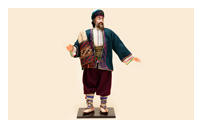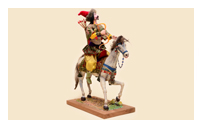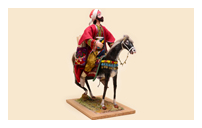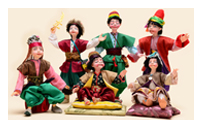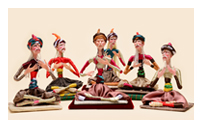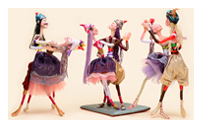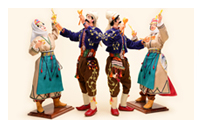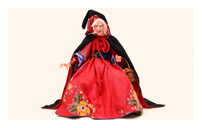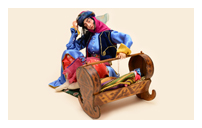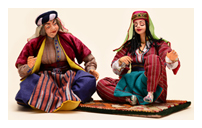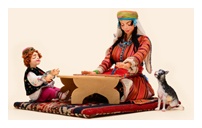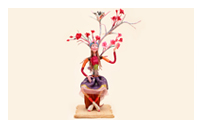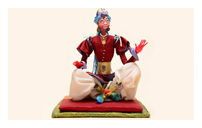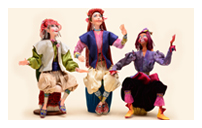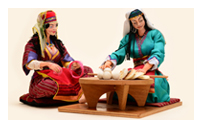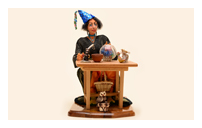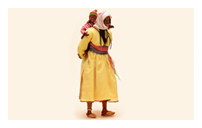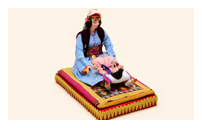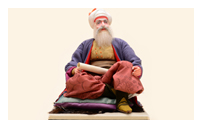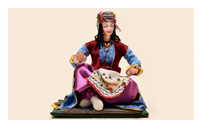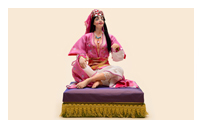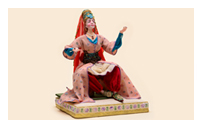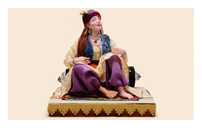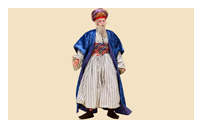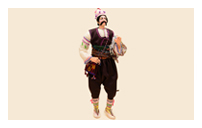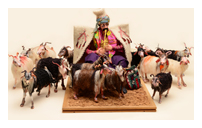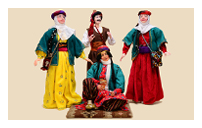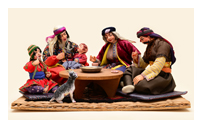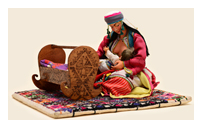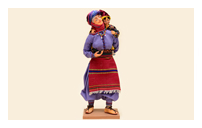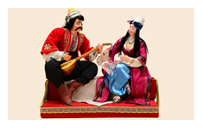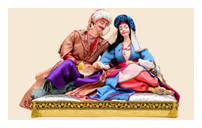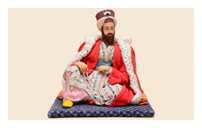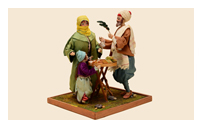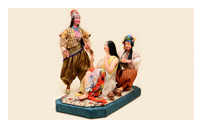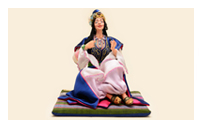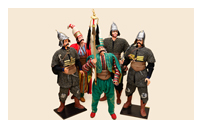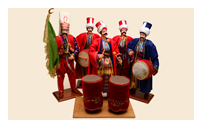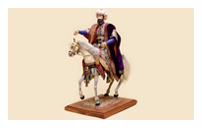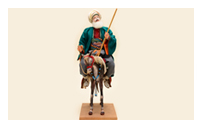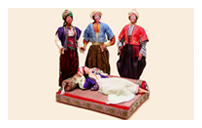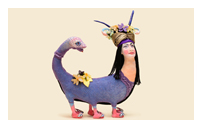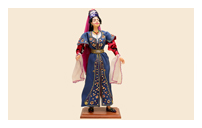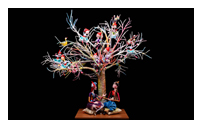-
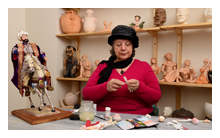
DOLL ART
Just as we don't know how language originated, we also don't know how art came to be. This being said, when we consider activities such as the construction of temples and dwellings, painting, sculpture, and handicrafts, it's clear there isn't a single community in the world that lacks artists. Renowned art historian Ernst Gombrich stated: "There really is no such thing as art. There are only artists. People who used colorful soil to scribble pictures of bison on cave walls back in the day, who presently buy paint to make publicity posters, and who have produced many other things over the centuries..."
The further back we go in history, the clearer and yet wilder seem the purposes art is believed to have served. In primitive communities, there is no difference in terms of usefulness between building a shack and creating an image. While shacks protect people against forces of nature such as the sun and the wind, images protect them against other forces just as real as the natural ones. This is to say that it's used with an incantatory purpose.Primitive art follows this predetermined path, but it also allows the artist to show his/her own talent. The technical mastery achieved by some tribal craftsmen is truly astounding.
Dolls have always served the incantatory purpose of art the most. Doll making, which also has an important place in Turkish folklore, is of course not used with an incantatory purpose today.In our day, cotton-tragacanth doll art especially, is a reflection of life and culture. It's a miniature copy of real life. Unfortunately though, this is a handicraft that has all but died out in Turkey, while losing nothing of its popularity in the rest of the world. What is more, the tragacanth-cotton technique that is unique in the entire world is used, distinguishing Turkish dolls significantly from others.
Doll art today has come to surpass the view of dolls as toys, to be acknowledged worldwide as an artistic language of expression such as painting and sculpture. Dolls of the world represent each country's national values as much as they display the imagination of artists. The field has its own market with quite a few artists, artists' associations, collectors, brokers, and book and magazine publishers. For instance in the USA where doll art attracts the most attention, magazines about dolls can sell up to 25 thousand copies.In addition, various doll museums are found in many countries such as the USA, Germany, Austria, and Japan.
Dolls in Anatolian Tradition and World Cultures
While the beginning of the 20th century marks the development of doll making as an art, this practice dates back several centuries in our folklore. It has come to be used in Anatolian villages during rain prayers and spring ceremonies for the most part,as a symbol with incantatory properties.
READ MORE -
READ MORE

LÜTFİYE BATUKAN AND THE SILENT WITNESSES TO HER LIFE
Lütfiye Batukan has created an extensive collection in her life of art exceeding fifty years: A giant collection of a thousand dolls that are all her own work. This collection can easily be deemed unique, as it consists entirely of dolls she made herself. It's certainly possible to collect a lot of dolls, but it's not easy to make so many. The artist is currently in possession of a little army of one thousand. The majority of the dolls she brought to life are those with traditional clothes. She has portrayed the people of Central Anatolia, the Aegean, the Black Sea and the Southeast in all their truth. Villagers after their ox plowing the field, shepherds playing flute to their sheep, Anatolian women spinning, weaning their babies, and rolling out dough, families eating at a floor table, village children atop donkeys, bridal processions... Each has been depicted in their authentic environment, wearing the traditional clothes of their region. Aside from dolls in traditional clothing portraying the Anatolian person in all his/her truth, you might encounter familiar faces in the collection as well. They will reach out to you from history's yellowed pages... Those hands reaching out might belong to the Magnificent Suleiman, to Sinan the Architect, or to Yunus Emre... Important figures in Turkey's history, such as Ataturk, Mehmet the Conqueror, Suleiman the Magnificent, Haji Bayram Wali, Nasreddin Hodja, Yunus Emre and Rumi occupy a privileged place in the collection. These dolls aren't just history come to life, but also life itself... The artist also has works where the real turns into dream, and the concrete turns into fiction, such as Santa Clause, Ali Baba and the Forty Thieves, and Snow White and the Seven Dwarves… Crowded compositions such as whirling dervishes and the Mehter [Ottoman avant-garde] Troops are the product of great efforts and patience.
These little witnesses of the artist's life are silent, but the expressions on their faces and their bodily movements help them come to life. And that is in fact the most important quality of Lütfiye Batukan's dolls: that they have facial expressions and body movements just like a real person does... The artist who attracts attention abroad as well with her different technique, makes her dolls using the tragacanth and cotton technique special to Turkey. Tragacanth, which is also used in the food sector, is a kind of glue made from astragalus herbs that grow in Anatolia, whichyields perfect results when combined with cotton. Texture most akin to human skin is obtained through the combination of tragacanth and cotton. Aside from these two principal materials, Batukan uses numerous others such as wires of different thicknesses, paper, antique and local fabrics, leather, and wool.
-
Lütfiye Batukan's dolls on display at the Yokohama Doll Museum
Lütfiye Batukan's exhibition at Yokohama Doll Museum opened June 6, 2015 can be viewed until 20 July. Yokohama Deputy Mayor Katsunori Watanabe, Yokohama Municipal Tourism Bureau and Museum Director Toshiyoki Aoki and Director of Yunus Emre Institute in Tokyo Telat Aydin attended the exhibition opening with contributions Yunus Emre Institute. The artists and the managers have cut the ribbon by wearing white gloves which are symbol of respect in Japan.
Selected 150 dolls from 1000 dolls of Lutfiye Batukan's extensive collection are taking part in this exhibition. Historic characters like Mehmed the Conqueror, Janissary Band, Yunus Emre, Mevlana, 4. Murat, Genghis Khan, Evliya Çelebi, Hürrem Sultan and works that reflect the tradition of the Anatolian people on display. The artist who makes effort to cherish this vanishing crafts in our country and to introduce Turkish dolls abroad says that the exhibition in Japan was more important as well as the exhibition in Europe and the United States: "In Japan, great importance was given to the doll art, doll artist are respected as cultural values . So I am honored for my exhibition in Yokohama appreciated by the Japanese."
Is expected 8 thousand visitor to the exhibition in the Yokohama Doll Museum, opened in the beginning of the 125th anniversary of Turkish- Japanese friendship relations.
"A Cotton World- Lütfiye Batukan" has been published
The book about Lütfiye Batukan's life and works "A Cotton World- Lütfiye Batukan" by Fatma Batukan Belge has been published with the Kosmos Publishing label. Turkish- English, 120 page, printed on glossy paper book designed by Sezen Kaya.
In the first part of the book is given information about doll art in the world and in Turkey. In the second part Lütfiye Batukan tells the doll making techniques with cotton – tragacanth and shares her technical tips and tricks with the enthusiasts. In the third section, the artist is under the spotlight since the beginning of 50 years of artistic life. A selection from the rich collection of 1000 dolls constitutes the fourth section. The latter part so biographical interview with Lütfiye Batukan is one of the most colorful part of the book. Long interview with the artist by her daughter Fatma Batukan Belge, touching the touchstones of her life since childhood and her art enjoy the reader on a journey.
READ MORE -
faces like a sculptor, the artist sews, embroiders and dyes their clothes with the dexterity of a seamstress.
The fact that neither the characters she makes based on real people nor her fictional ones look alike is precisely what these dolls have in common. Symbolic characters of Turkish culture, folklore and history have been portrayed in their authentic clothes and environment.The artist even made sure that the embroidery on an Anatolian woman's three skirts be true to fact. She went to see the Mehter Troops at the Military Museum every week for two years the time she made the Mehter Troops, trying not to skip any details. From the dolls' clothes to their accessories, every element is important for Lütfiye Batukan... She has recreated the shepherd's sheep, the bard's lute, and the baby's crib when necessary. And while reality is an important feature in Batukan's work, its opposite, imagination and fiction have been equally important. In recent years especially, she has created more abstract characters and more eclectic figures. "Gratitude" dolls or works such as "The Tree of Life" are the latest examples of these types of works. Her"Ada Dolls", inspired by her granddaughter Ada, are also worthy of note among her recent works.
What brought Lütfiye Batukan, the creator of a giant little army of one thousand, to this day was her creativity, imagination and ambition. She too is a child of Anatolian soil, the cradle of innumerable traditions. Through an interesting coincidence, she was born in Kayseri, where they grow astragalus, the herb from which tragacanth, a principle material of doll making is made. A careful observer of nature and her surroundings since childhood, Lütfiye Batukan's interest in doll making begins at a very early age. In the beginning, she made dolls out of pieces she stole from the dough her grandmother rolled out while making dumplings, as well as from mud and clay. Afterwards she moved on to rag dolls. She put a coin at the end of a T shaped piece of wood, covered it with cloth and drew the facial features. She used to play for hours in the depot full of fabrics that her peddler father sold going around Anatolia, and combined these fabrics with her imagination. The turning point came when they moved to the capital city. She was fascinated by the sculptures in the Archaeology Museum in Kaleiçi and constantly played in the museum's garden. The dolls she saw on the vitrine of the Advanced Technical School for Girls one day marked the beginning of her career. She was surprised to realize that the dolls she'd made as a child shown some technique, and decided to take classes in the subject.
After learning the technique in Evening Art School for Girlsin 1960, her work with dolls started to get more serious. She applied her researchinto historical and traditional garments onto dolls and opened her first solo exhibition in 1977 in the French Cultural Center in Ankara. This wassucceeded by an exhibition in the Ottoman Bank's Ankara Art Gallery the same year.In 1978, she held exhibitions at the Hilton and Intercontinental Hotels in Istanbul and in the Yapı Kredi Kazım Taşkent Art Gallery.
READ MORE -
These receive names such as Hemecik, Korçak, Çömçe, and Gelin Karaçör game or dance. Dolls are in fact known to be the world's oldest toys; it's been discovered that some of the statuettes found in Hittite, Phrygian, Bronze Age andNeolithic periodlayers and understood to have featured in religious ceremonies were used as toy dolls, and some had to do with the mother goddess cult. Clay figurines with painted faces and hair attached to their heads have been found in the Hacılar mound near Burdur province.
Wooden doll and god statuettes that the natives used to cast spells have been found in Ancient Egypt and among Native Americans. Dolls in Africa, on the other hand, recall engraved wooden fetishes. The Fingo people in Orange used to carry a doll with them as a lucky charm until their babies were born. In ancient Japan, dolls were regarded as living, and were clothed and fed. In India where people got married at a very young age, meticulously clothed dolls would be given as gifts among Muslims and Zoroastrians when a girl was getting married. And in some underdeveloped societies of the East, young girls were not given dolls because these were believed to harbor evil spirits (djinns). Folk healers or magicians all over the world have always practiced this common spell: After making dolls that roughly resemble an enemy, they have pierced the hearts of these dolls or burned them, in the hopes that the damage would befall the enemy in question. The puppet burned in England on Guy Fawkes' Day is a remnant of the same superstition.
Doll Art in Turkey
Although doll art, which dates as far back as the history of humankind, is all but disappearing in Turkey, the first doll exhibition was actually held in our country in 1936. European Red Crosses were among the attendees of the "International Doll Exhibition" that opened in Taksim Municipal Garden on August 8th, 1936. Twenty countries sent in dolls for the competition and exhibition. The Istanbul Consuls of these countries, parliamentary members, the press and the Red Crescent Foundation were present at the opening. The program prepared for the duration of the exhibition was really colorful as well, with parts from operettas and opera overtures presented in public concerts wherefamous artists of the time such as Bedia Muvahhit, Hazım Körmükçü, and Münir Nurettin performed.
Dolls from foreign Red Crescent and Red Crosses, as well as those made for exhibits and for sale were featured in the exhibition comprising 340 dolls in total. Ms. Zahide Müfide made the Bride and Groom doll from Ankara in exchange for 25 liras in the currency of the time. Some dolls were put up for sale at the end of the exhibition, and doll owners were paid, reserving a certain sum for the foundation. In addition, Evening Art School for Girls teacher Mr. Mazhar, Academyprofessor Mr. İsmail Hakkı, Mr. Edip Hakkı and Ms. Nanasofa participated with dolls they made specifically for the exhibition. The exhibition drew so much attention that even though it had been announced that it would stay up for fifteen days,it stayed open for a month and received 28 thousand visitors.
READ MORE -
As for the jury in the competition, it was made up of Cemal Nadir Ramiz, Münif Fehim, Melek Hanım, Ayşe and Ertuğrul Muhsin. Zehra Müfit's three-part composition titled "Scrivener" was awarded first place.These dolls, along with seven others, were placed in the lottery that took place in public.
Doll exhibitions were held many times after this one, both in Turkey and in the world. The same year, doll making classes were opened at the Evening Art School for Girls and the Advanced Technical School for Girls. The Red Crescent Foundationalso opened doll making classes within its rehabilitation efforts program for people who worked with the infirm in their dwellings. They helped sell the dolls made by the students. The great interest in the first exhibition gave The Red Crescent the courage to hold exhibitions from time to time, and thus the Eminönü Branch of Turkey's Red Crescent Foundation had three other international exhibitions in the years 1950, 1954 and 1963. These exhibitions had a great role in the emergence of doll art in Turkey.
The first important doll artist of the country is Zehra Müfit Saner, who came first in the initial competition. Born in Ankara in 1880, Zehra Müfit was a pioneering and enterprising woman not only in doll making, but also in the newly established Republic of Turkey. Coming from the Hacı Bayram Veli family, Müfit was very interested in painting and handicrafts from a very early age. She hadn't left Ankara, then small as a village, until after she got married. But the paintings she made using her imagination looked so real that they displayed her talent. In the following years, she was able to combine this talent of hers with entrepreneurship. Hers was the first studio in Turkey to be opened by a Turkish woman. In her studio she accepted handicrafts, decoration and stitching orders from London and from the USA. When Ataturk first came to Istanbul, Zehra Müfit prepared all his belongings, furnished the Ertuğrul yacht, and even hand embroidered the flag of the automobile gifted to him by the nation. But the fact that she started working on dolls was by coincidence; she'd started working in this field after coming first in the doll exhibition and competition organized by the Red Crescent, and developed her craft over time. In her effort to pass this art form on to further generations, she started teaching."The aim in making these dolls and teaching the technique is to prevent their being forgotten or lost. Here are the mendicants, the Mawlawis, the Janissaries,all dressed according to their time. I do think that all these also constitute the first materials for a clothes museum. Another aim of mine is to energize children of the country and incite them to go into commerce. I think that a woman must help her husband out even if he doesn't need her to, and not be a burden. And for that, she should be able to make money. It mustn't be forgotten that something completely unexpected and original can be met with great interest."Having started doll making at a later age, she was perhaps unable to complete all the compositions she had in mind, but she hoped her students would finish what she hadn't had time to do.
READ MORE -
If Zehra Müfit Saner is the first representative of doll art, we can assert that its most important representative in our day is Lütfiye Batukan. In the last 50 years, Lütfiye Batukan has raised dolls,previously considered knick-knacks, to the status of art. She is the most competent figure that comes up when we mention doll art in Turkey today. Working in this field non-stop for as long as half a century, shehas a collection of almost a thousand dolls in her possession. The artist, who uses tragacanth and cotton as her principal materials while making dolls, draws her subjects from Turkish folklore and great Ottoman history.
-
She took a break from her work with dolls in the beginning of the 80's due to health problems, and began to do ceramics.. Producing authentic works in this field as well, the artist still continues working with ceramics.
In 1986, Batukan had an exhibition in the Ataturk Library. She participated in the exhibition titled "A Glimpse of the Creative Turkish Woman"held in the Ataturk Culture Centerin 1987, as well as in the exhibition organized by the Foundation for the Preservation of Historical Houses in Turkey, and one held in Egypt by the Ministry ofCulture and Tourism as part of the Conference on Islam. She gained recognition in Turkey for the first time after receiving an achievement award at the"International Folklore Dolls Competition"in Polandin 1985. She then won first prize in the "National Folklore Doll Competition" held in Turkey for the first time in 1986. And again the same year, she started to work at the Turing Istanbul Handcrafts Center in Sultanahmet. The artist still continues her work there.
The current aim of the artist, who has directed her exhibitions abroad since 1990, is to promote Turkish culture abroad using dolls. Batukan, whose dolls have been exhibited in cities such as Marburg, Frankfurt, Basel and Vienna,attended the conference organized by NIADA, the National Institute of American Doll Artists in Chicago in the year 2000. Lastly, the exhibition she had at the Turkish House in New York, October of 2006 drew a lot of interest. One of the artist's dolls has also been featured in the catalog of the Textile Museum in the US. Another one of Batukan's dolls dressed in traditional Turkish clothing, which received media attention not only in Turkey but also abroad, is included in the Lousie Fecher's book, titled "Here Comes The Bride Dolls". The owner of a large collection of bride dolls, Fecher's book features traditionally clothed bride dolls from various countries all over the world. Lütfiye Batukan represents Turkey with a composition of an Anatolian bridal procession. An important reference material for experts and collectors ofdoll art, the book presents a small piece of our traditional culture and folklore to those interested.
Lütfiye Batukan continues her work today in the Istanbul Handcrafts Center brought to life by Çelik Gülersoy and located in Sultanahmet, one of Istanbul's most important historical districts. However, her biggest fear is that this art form will be lost after she is gone. Raising new artists is almost impossible, since patience, talent, creativity, curiosity for research, and respect for tradition all come together in few very people. Batukan's greatest aim and goal now is to set up a doll museum like those found elsewhere in the world. Turkey's first doll artist Zehra Müfit Saner wanted to set up a clothing museum. Even though she didn't live to see it, with the Sadberk Hanım Museumfounded by Sevgi Gönül of the Koç Family,her dream in a waycame true. However, Turkey still awaits a serious doll museum: one that will provide a window into the colors of the geography we inhabit, our millennia of history and our rich culture!

